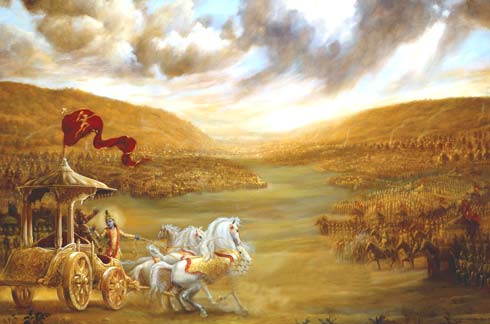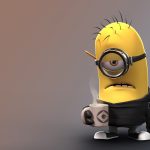At brāhma-muhūrta (before sunrise), Śaṅkhacūḍa got up from his flower-strewn bed. He discarded his night clothes, bathed in pure water, put on freshly washed clothing, and smeared his body and forehead with bright tilaka markings. He performed the necessary rites and worshiped his personal Deity.
He then saw such auspicious things as curd, ghee, honey, parched rice, etc., and, as usual, distributed to the brāhmaṇas the best jewels, pearls, clothing and gold. To make his departure for war favorable, he gave to his guru some pearls, gems and diamonds, and he gave to the poor some horses, elephants and cows. He then gave to the brāhmaṇas a thousand storehouses, three lakhs (300,000) of towns and seven lakhs (700,000) of villages. He installed his son Sucandra as the acting king and entrusted to him the care of his family, kingdom, treasury, subjects, wealth, storehouses and conveyances.
Śaṅkhacūḍa dressed himself for war and armed himself with bow and arrows. The king ordered the armies to gather, so three hundred thousand horses, one hundred thousand elephants, ten thousand chariots, three crores of archers (30 million), three crores of armed soldiers, and three crores of trident holders readied themselves for battle. After counting his forces, the king appointed a mahāratha, an expert in the science of warfare, as commander-in-chief over three lakh akṣauhiṇī forces (300,000). [An akṣauhiṇī is a whole army consisting of 109,000 foot soldiers, 65,610 horses, 21,870 chariots and 21,870 elephants]. Ordering three akṣauhiṇīs to beat war drums, he remembered Lord Hari and emerged from the pavilion. Śaṅkhacūḍa rode on a fine chariot and, headed by his guru and his elders, left for Lord Śiva’s place.
Lord Śiva at that time was staying on the banks of the Puṣpabhadra River at Siddhāśrama. This holy place was known to enable sādhus to easily attain perfection in yoga. It was here that Lord Kapila practiced asceticism, and thus devotees of Lord Kapila went there and did the same. The place was bounded on the west by the western sea, on the east by the Malaya mountain range, on the south by the Śrī Śaila mountain, and on the north by the Gandhamādana Mountain. The Puṣpabhadra River was forty miles wide and four-thousand miles long. This auspicious river offered great spiritual merit, and was always full of transparent, sparkling water. She is the favorite spouse of the Lavaṇa (salt) ocean and is indeed very sacred. This river issues from the Sarasvatī in the Himalayas and, keeping the Gomatī River on her left side, she eventually merges with the western ocean.













